Long-tailed mouse facts for kids
Quick facts for kids Long-tailed mouse |
|
|---|---|
 |
|
| Conservation status | |
| Scientific classification | |
| Genus: |
Pseudomys
|
| Species: |
higginsi
|
The long-tailed mouse (Pseudomys higginsi) is a special kind of mammal that lives only on the island of Tasmania in Australia. It's a type of rodent, like a regular mouse, but with some unique features!
This mouse is an omnivore, which means it eats both plants and insects. You can find it living in forests, especially in rocky, high-up areas called sub-alpine scree (which are slopes covered in loose rocks). It often makes its home in burrows underground.
The long-tailed mouse weighs about 70 grams, which is roughly the same as a small apple. It's easy to spot because of its amazing tail! The tail is two-toned: white underneath and dark on top. It's also super long, about 1.3 times longer than its head and body put together. Scientists think this long tail helps the mouse keep its balance when it jumps around on rocks.
Scientists have even found old bones, called fossils, of this mouse! These fossils were discovered in Cloggs Cave in Victoria, Australia. They are between 12,000 and 20,000 years old, showing that this mouse has been around for a very long time!
Contents
Meet the Long-Tailed Mouse!
Where Do They Live?
The long-tailed mouse lives in many different places, from sea level all the way up to mountains about 1,200 meters high. They especially like wet forests and areas that get a lot of rain.
These mice are very adaptable! This means they can live in many kinds of environments and handle changes to their homes, like when forests are managed by people. Studies have shown that the long-tailed mouse can thrive even in forests where some trees have been harvested. In fact, they were found to be just as common in different types of managed forests.
A study from 2012 looked at where these mice used to live compared to where they live now. It found that even though some of their old habitats have changed, the long-tailed mouse is not as endangered as you might expect. This is good news for this unique Australian mammal!
What Do They Eat?
The long-tailed mouse is an omnivore, meaning it eats both plants and animals. It's also an "opportunistic generalist," which means it eats whatever food is easiest to find at different times of the year.
Scientists studied what these mice eat by looking at their droppings (poop!). They found that the mice enjoy a wide variety of plant foods, including grasses, grains, bamboo, fruits, ferns, and mosses. They also eat different kinds of fungi (like mushrooms) and many types of insects. So, they have a very varied diet!
Mouse Life: Day and Night
The long-tailed mouse is mostly a nocturnal animal, which means it is most active at night. However, sometimes you might spot them moving around during the day too!
They live in many different types of plant environments. These include lush rainforests, wet scrublands, eucalyptus forests, grassy sedgelands, and even the low-growing plants found in high alpine areas.
Interestingly, the number of long-tailed mice in an area can be linked to other animals living there. For example, studies have shown that where there are more swamp rats, there are often more long-tailed mice. On the other hand, if there are many feral cats (wild cats) or Tasmanian devils around, there tend to be fewer long-tailed mice. This is because cats and Tasmanian devils are predators that hunt small mammals.
Growing Up: The Life Cycle
Long-tailed mice usually have their babies during a specific time of year, from September to June. A mother mouse carries her babies for about 31 to 33 days. When the babies are born, a mother typically has about 3 young in a litter (a group of babies born at the same time).
The young mice grow up quite quickly! They become fully independent from their mother about 33 days after they are born. They reach their adult body size around 40 days old. Their tails, however, keep growing until they are approximately 75 days old.
Both male and female long-tailed mice look very similar; there isn't a big difference in their size or appearance. However, mice from different parts of Tasmania might have slight differences in their body weight, the length of their back feet, or their tail length.
Like all mammals, mother long-tailed mice nurse their young with milk. The babies hold onto their mother's nipples, which allows the mother to move quickly or escape danger while still carrying her young.


